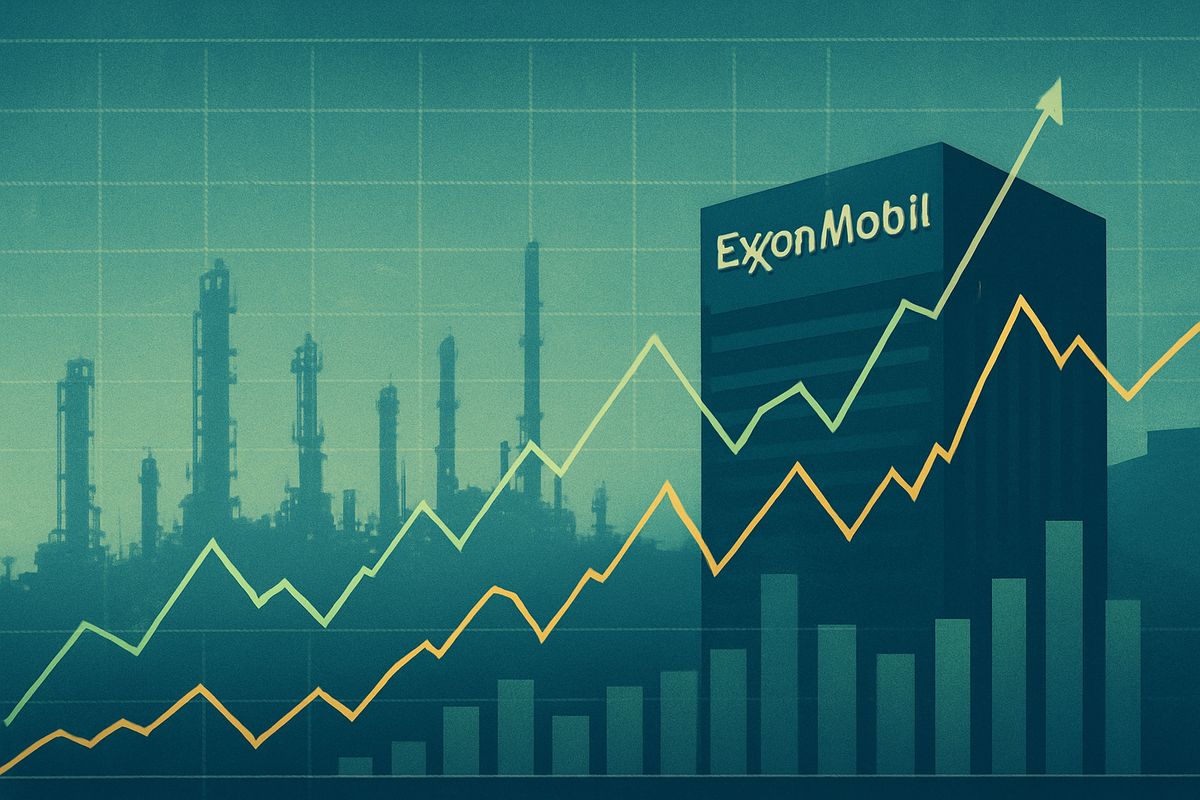
As the financial world braces for another crucial earnings season, all eyes are turning to energy titan ExxonMobil (NYSE: XOM), whose third-quarter 2025 financial results are set to be unveiled on Friday, October 31, 2025. With the current date being October 29, 2025, the market is rife with anticipation, dissecting preliminary considerations and commodity price movements to gauge the supermajor's performance. The upcoming report is expected to offer critical insights into how the company navigated a quarter marked by fluctuating, yet generally range-bound, crude oil prices and strategic operational shifts.
The imminent earnings release is more than just a routine financial disclosure; it's a barometer for the health of the global oil and gas industry and a testament to ExxonMobil's strategic resilience. Investors and analysts are keen to see if the company's integrated business model, particularly its refining and chemicals segments, can offset the impact of moderating crude oil prices compared to previous highs. The outcome will not only influence ExxonMobil's stock trajectory but also set a precedent for other industry players and shape broader investment sentiments in the energy sector.
Navigating Q3: Anticipated Performance and Market Dynamics
ExxonMobil's Q3 2025 performance is under intense scrutiny, with analysts offering a range of projections. The Zacks Consensus Estimate pegs Earnings Per Share (EPS) at $1.78, signaling a potential year-over-year decline of 7.3%. Revenue forecasts hover between $82.8 billion and $86.8 billion, with Zacks estimating $86.8 billion, a 3.6% decrease from the prior year's actuals. Despite these projected declines, some analysts, like JP Morgan, forecast a potential EPS of up to $1.86, suggesting a possible beat over the consensus, driven by the company's robust operational efficiencies and integrated structure.
The third quarter of 2025 (July, August, September) witnessed crude oil prices generally range-bound. West Texas Intermediate (WTI) crude oil spot prices averaged approximately $65.74 per barrel for Q3 2025, with a downward trend from July ($68.39) to September ($63.96). Brent crude oil prices, a global benchmark, saw a modest 2% increase from the previous quarter, averaging around $68.17 per barrel for Q3 2025. These price levels, while healthy, represent a moderation from the highs seen in earlier periods, putting pressure on upstream (exploration and production) profitability.
ExxonMobil's own preliminary "earnings considerations" shed light on internal expectations. The company indicated that changes in liquids prices could impact the bottom line by a loss of $100 million to a gain of $300 million sequentially, while natural gas price changes were anticipated to have a sequential impact ranging from a $200 million loss to a $200 million profit, with natural gas prices leading to a sequential increase of $200 million in September quarter earnings. Crucially, the refining segment is expected to be a significant positive, projected to boost earnings by an additional $300 million to $700 million due to stronger industry refining margins. The chemicals division is also expected to contribute positively, with an anticipated increase of $100 million to $300 million.
Beyond financial projections, ExxonMobil made several significant announcements during Q3 2025. The company declared a quarterly dividend of $0.99 per share, paid on September 10, 2025, reaffirming its commitment to shareholder returns. A major strategic move was the final investment decision for the Hammerhead development offshore Guyana, the seventh project on the Stabroek block, anticipated to commence production in 2029 with a capacity of approximately 150,000 barrels of oil per day and an estimated cost of US$6.8 billion. Furthermore, reports indicated a potential re-engagement with Iraq, with discussions surrounding an agreement to manage, develop, and operate the Majnoon oil field. Conversely, restructuring costs, including a recently announced global layoff of 2,000 employees, are expected to negatively impact overall earnings by $400 million to $600 million.
Winners and Losers: The Ripple Effect Across the Energy Sector
ExxonMobil's (NYSE: XOM) imminent Q3 earnings report, set against the backdrop of Q3 2025 oil prices averaging in the mid-$60s per barrel, presents a nuanced picture for the company and its peers. While upstream earnings might face headwinds from the moderate crude prices compared to earlier quarters, the strength of its integrated model is expected to be a significant advantage. The anticipated boost from refining and chemicals segments, driven by robust margins, positions ExxonMobil to potentially outperform less integrated rivals. This diversification allows the company to capture value across the entire energy value chain, mitigating some of the volatility inherent in crude oil prices alone.
For other major oil and gas companies, the implications are varied. Integrated supermajors like Chevron (NYSE: CVX), Shell (NYSE: SHEL), and BP (NYSE: BP) are likely to exhibit similar trends, where their downstream operations (refining and chemicals) could partially offset any softness in upstream profits. Companies with a higher pure-play upstream exposure, however, might find the Q3 oil price environment more challenging, potentially leading to lower earnings compared to periods of higher crude prices. Their profitability will be more directly tied to the cost of extraction and the prevailing market price of crude.
The broader energy sector will also feel the ripple effects. Oilfield service companies, which rely on capital expenditure from producers, might see continued demand for their services, especially given ExxonMobil's commitment to projects like Hammerhead in Guyana. However, if overall industry spending tightens due to sustained lower crude prices, their revenue growth could slow. On the other hand, the petrochemical industry could benefit from lower feedstock costs if crude oil and natural gas prices remain subdued, boosting margins for companies in that space. The continued emphasis on cost efficiencies and strategic project development, as seen with ExxonMobil, underscores a broader industry trend towards optimizing operations in a more price-sensitive environment.
Wider Significance: Industry Trends and Geopolitical Undercurrents
ExxonMobil's anticipated Q3 2025 performance, particularly the strength of its refining and chemicals divisions, underscores a significant broader industry trend: the increasing importance of integrated operations in navigating energy market volatility. As crude oil prices fluctuate, companies with diversified revenue streams and robust downstream capabilities are better positioned to maintain profitability and stability. This trend highlights a strategic pivot among supermajors to de-risk their portfolios from sole reliance on upstream production, fostering resilience in an unpredictable global energy landscape.
The company's substantial investment in the Hammerhead project in Guyana also reflects a continued commitment to high-return, low-cost conventional oil production, a critical strategy for maintaining competitiveness amidst the global energy transition. This move signals that while renewable energy gains traction, conventional oil and gas will remain vital for decades, with companies focusing on optimizing existing assets and developing new, efficient resources. The potential re-entry into Iraq’s Majnoon field further illustrates the strategic importance of accessing prolific, yet sometimes geopolitically complex, reserves to secure future production volumes.
Geopolitical factors continue to cast a long shadow over the oil market. While Q3 2025 saw generally range-bound prices, the underlying tensions in key oil-producing regions and the ongoing dynamics within OPEC+ (Organization of the Petroleum Exporting Countries and its allies) always pose potential ripple effects. Any shifts in production quotas or supply disruptions can quickly alter market fundamentals, impacting not only ExxonMobil but also global competitors and consumers. Regulatory and policy implications, particularly those related to climate change and emissions, also influence long-term investment decisions and operational strategies, pushing companies to balance traditional fossil fuel production with cleaner energy initiatives. Historically, periods of moderate oil prices have often spurred greater efficiency drives and consolidation within the industry, and ExxonMobil's recent restructuring efforts align with this pattern, aiming to streamline operations and reduce costs.
What Comes Next: Strategic Pivots and Market Outlook
Looking ahead, the immediate focus for investors will be on ExxonMobil's (NYSE: XOM) official Q3 2025 earnings report on October 31. The report will provide definitive figures on production volumes, segment-specific profitability, and capital expenditure, offering a clearer picture of the company's financial health. Beyond the headline numbers, investors will be scrutinizing management's commentary on the outlook for Q4 and into 2026, particularly regarding crude oil demand, supply dynamics, and any updates on strategic projects like Guyana and potential ventures in Iraq. The company's guidance on future capital allocation, including share buybacks and dividends, will also be closely watched.
In the short term, the trajectory of crude oil prices will remain a dominant factor. While Q3 saw moderation, geopolitical developments, global economic growth forecasts, and OPEC+ decisions could swiftly shift market sentiment. ExxonMobil's diversified portfolio, with its strong downstream assets, offers a degree of insulation, but sustained low oil prices would inevitably pressure upstream profitability. Conversely, a rebound in crude prices could significantly boost earnings, especially from its high-margin production assets.
Long-term possibilities for ExxonMobil involve a continued balancing act between maximizing value from its core oil and gas business and strategically investing in lower-carbon solutions. The Hammerhead project in Guyana exemplifies the former, while the company's ongoing research and development into carbon capture and storage (CCS) and biofuels represent its foray into the latter. Potential strategic pivots could include further portfolio optimization, divestment of non-core assets, or accelerated investments in emerging energy technologies. Market opportunities may arise from growing global energy demand, particularly in developing economies, while challenges include increasing regulatory pressures, competition from renewable energy sources, and the inherent volatility of commodity markets. Investors should anticipate continued emphasis on capital discipline, operational efficiency, and selective, high-return project development.
Comprehensive Wrap-up: Assessing the Path Forward
ExxonMobil's (NYSE: XOM) Q3 2025 earnings prospects highlight a critical juncture for the energy giant, showcasing its resilience amidst a fluctuating oil price environment. The key takeaway from the pre-earnings analysis is the expected strength of its integrated business model, particularly the refining and chemicals segments, which are poised to provide a significant buffer against the moderation in crude oil prices experienced during the quarter. This diversification underscores a strategic advantage that allows the company to maintain profitability even when upstream conditions are less favorable, a crucial lesson for the broader energy market.
Moving forward, the market will assess ExxonMobil's ability to sustain its operational efficiencies and capitalize on strategic growth projects, such as the massive Guyana developments. The imminent earnings report will be instrumental in confirming the anticipated positive contributions from downstream operations and providing clarity on the financial impact of restructuring efforts and new investments. The company’s consistent dividend policy, alongside its strategic project commitments, signals confidence in its long-term financial health and ability to generate shareholder value.
The lasting impact of this period will likely be a reinforced industry focus on integrated operations, capital discipline, and strategic asset development in high-return areas. For investors, the coming months will be critical. They should closely monitor the actual Q3 results for any deviations from expectations, pay attention to management's guidance on future capital expenditures and production outlooks, and observe the evolving global crude oil supply-demand dynamics. Additionally, any further announcements regarding ExxonMobil's energy transition initiatives and international project developments, particularly in regions like Iraq, will offer further insights into the company's long-term strategic direction and its capacity to thrive in a dynamically changing global energy landscape.
This content is intended for informational purposes only and is not financial advice





